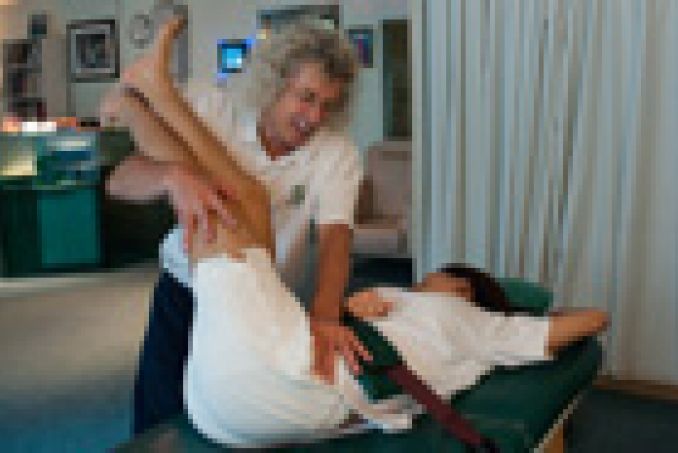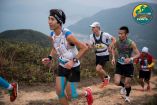STRETCH YOUR RUNNING
By Chris Watts
(CSO STRETCH LTD)
Pre-race, aside from calming jittery nerves and talking tactics, most athletes do some half-hearted stretching – but how many of us are sure that what we are doing is really helping our performance?
One of the most misunderstood, and yet essential components of an active lifestyle, stretching pumps blood right into the tendon junctions carrying oxygen to where we need it most when the stop watch is ticking. It can prevent injuries, increase athletic performance and help you maintain an optimally functioning, well-tuned body.
Chris Watts
Chris Watts and his team of professional Stretch therapists are Hong Kong’s resident stretch specialists. Working from the Stretch studio in Central, Chris and his team have has the unenviable task of ironing out the aches and pains of many full and part-time athletes, who have run into muscle problems due to postural and flexibility problems. Injuries which he believes can easily be prevented.
“Weekend warriors do their cardio and strength work but hate stretching,” he says. “And they mostly stretch in the wrong fashion.”
“The body is not designed for a sedentary life,” he adds. “It takes on board your habits and is a history of everything you do, in physical form. After sitting all day long in front of a computer, your quads and hip flexors are short, tight and contracted, and have been like that for eight hours. It’s the same when you wake up in the morning. You have been in a contracted, dormant position for eight hours. In both cases, it is hard to stretch out before you get moving.”
“The difference between winning the race, or not, is not necessarily all about training, but also how flexible the athlete is. Over 100 yards, one athlete takes 30 strides, one takes 29, the 29 stride person will likely win. Strength and flexibility equals power,” he emphasises.
The ideal stretch/strength ratio between the quads and hip flexors is 3:2 but most people are running on just 6:1 which means that people are leaning into their run, pulling themselves along rather than pulling and pushing themselves forward. This means they are not using their gluteals and hamstrings properly and missing out on a whole load of power.
AIS
So exactly what kind of stretches are going to help most? Watts practices and teaches the benefits of Active Isolated Stretching and Active Isolated Strengthening, two systems invented by Aaron Mattes, a former sports coach from the US who identified intrinsic problems with how pro athletes were limbering up. Thanks to his ground-breaking work AIS now has fans all over the sports work, including Tiger Woods and Paul Azinger. Watts is the founder of this work in Hong Kong and the only certified Instructor in Asia.
Posture
“Posture is crucial,” he says. “If your body is in correct alignment, with no tilt or rotation, it will be much more efficient. When you run you are putting three times your body weight on each and every structure of your body. If you have alignment problems and do a lot of exercise, they will be exacerbated.”
It is vital to understand your own body before taking on serious exercise. On a basic level, right handed people are usually stronger on their right side, and so to even the symmetry should work on strengthening their left side. But to get the most out of your exercise it pays to have a postural check before starting a regular routine.
Muscles most used
Identifying the muscle groups you are going to use the most in your sport is the next step. Usually it will be the lower body, the powerhouse, which includes hip flexors, quads, gluts, hamstrings, calves and your lower back. Then you pick stretches to target these muscles.
Stretching techniques
Most importantly you must make sure you are stretching effectively. Your target muscle needs to be as relaxed as possible, so you’ll probably stretch from a lying or sitting position. Bear in mind that there are always two muscles involved in a stretch, the driving muscle and the relaxing muscle, in AIS speak that’s the agonist and antagonist, respectively. For example when stretching your quads you necessarily contract your hamstrings.
Start out by focusing on the driving or contracting muscle then move slowly, until you reach your natural barrier or end point, for example when stretching your hamstring, your leg is as straight as it can go, and you can’t straighten it any further without stretching. This is the active part of the stretch. Whatever the stretch is, at the start, breathe in to oxygenate the blood, then passively pull through the barrier for no more than 2 seconds while exhaling (when the body is at its most relaxed), and release. Breathing out during the stretch also slows down the activation of the stretch reflex. At around the three second mark this reflex will kick in anyway, activating an-eccentric contraction, designed to protect the muscle by telling you you’ve gone too far. With AIS you shouldn’t be activating this reflex as the stretch is so brief as it could cause muscle tearing especially if you have unstable joints. Ten reps later, when the joints are well oxygenated you should be able to feel the difference already.
Avoid static stretching
“Static stretching actually REDUCES the blood going into the muscle, causing ISCHEMIA.” says Watts, “as the tissue is too hard and tight for blood to pass through. So, instead of oxygenating your blood you get a build up of lactic acid. You’ll trigger the protective stretch reflex while in full stretch, and if you already have an issue with your muscle you could sustain harmful micro tears.”
There’s no best time of day Watts reports, another myth de-bunked, although if you stretch first thing in the morning it sets you up for the day. “Kick start your body by pumping blood in, giving you a nice, warm, glowing feeling in the deeper recesses of your joints. You’ll feel light, bouncy and airy, as if everything is oiled up. When you’re warmed up like that before a workout you don’t even feel like you’re running.”
Back up with nutrition
It is essential to make sure you consume an adequate intake of proteins to feed your muscles. Protein before and after a race speeds up the recovery of muscle tissue. “Protect thy joints!” preaches Watts. “It is key to protect your joints particularly the cartilage which helps to lubricate the joints. And don’t forget your minerals. Minerals are essential for healthy muscles. Potassium, calcium, magnesium and sodium help cells absorb fluids. Each time you move you use up minerals. Take mineral supplements daily or you won’t hydrate your joints properly, your nervous system won’t function well and you’ll get muscle spasms.”
Watts also suggests drinking ion drinks to further help your electrolyte system. For fluids to pass through by osmosis into your cells requires positive to negative ionization. Positively charged ions allow that essential fluid into the muscle cells.
Team work
Although stretching on your own is definitely helpful, Watts suggests stretching with a partner or team member, so that you have someone to assist each stretch.
BOX – top tips
Preparation: get a posture check and learn which stretches are best for you and your exercise routine.
Pre Race: do stretches of the big 5 power muscles or just keep moving and keep warm
Post race: do stretchesof the big 5 power muscles immediately (take a rope or twist your sweater up to provide resistance) and if possible go for a lymph drainage massage which will hydrate and oxygenate your tissues and flush out all the bio junk (lactic and uric acid).
Daily: keep your body moving during the day. Set an alarm clock to go off every thirty minutes. Get up, turn it off, drink water and sit down again. This hydrates the discs in your lower back, decompressing the discs as you lift in your gait, flushing water in. When you plant your heel the discs compress again squeezing the water out. Take mineral supplements.
General: Listen to your body. If you start getting niggly pains while working out do something about them immediately. Your body is warning you. Don’t wait for them to become big issues.
Stretches:
The following stretches are good general exercises to be done daily.
Do 10 reps of each stretch, each leg.
Hold stretches for no more than two seconds, breathing in before, and breathing out during each stretch.
Always go back to neutral OR START POSITION between each stretch to flush the toxins and lymph back out of the muscle you have just stretched
They should be done in sequence.
1 Bent leg hamstring stretch. (Frames 6-10)
Lying on your back lift your leg in a bent position, rope around your foot. Straighten your
leg, find your barrier and then pull on the rope. Keep your hand on your knee to brace your leg.
2 hip flexor stretch.
Essential for opening up your stride and increasing speed. On one knee and one foot in a lunge position push forward until you hit your barrier. Then with one hand behind your hip and the other resting on your knee for stability, push forward. Make sure you keep your torso upright.
3 Quad
Lie on the edge of the table, leg dangling, rope around your ankle. Use your hamstring to bend your knee until you hit the barrier. Then pull on the rope. You should feel this through the knee joint and lower quad.
4 Lateral Glut
Lying on your back, lift your leg up and drive it across your body. At the barrier, one hand on the upper thigh and one on the shin of the active leg, pull and push across your body to stretch.
5 Lower back
Stretching out your spine helps keep your body upright. Because of prolonged sitting back muscles generally need lengthening. Sitting with your legs bent out to the sides with the rope around your feet, lean forwards until you hit your barrier. Then pull on the rope to activate the stretch.
6 Calf
“If you run with tight calves, you run like an elephant,” says Watts. “You should run by pushing the ground away from you.” Sitting with the active leg straight out in front of you, the other one relaxed, put the rope around your foot. Pull your toes in towards your body until you hit your barrier and then pull with the rope to activate the stretch.







678.jpg)

/CBREMKC_9735_HK_Logo web banner-01.jpg)
/RoyalInt300100banner.jpg)
/HysanWebBannerDesign300.png)